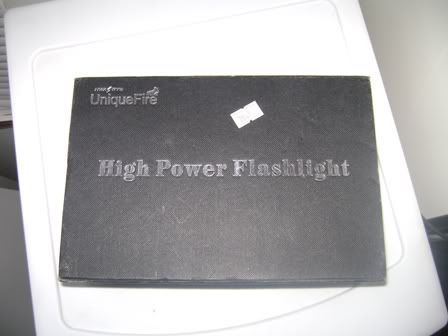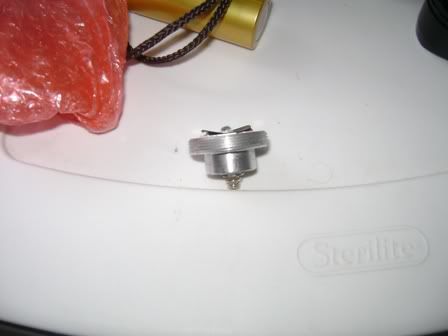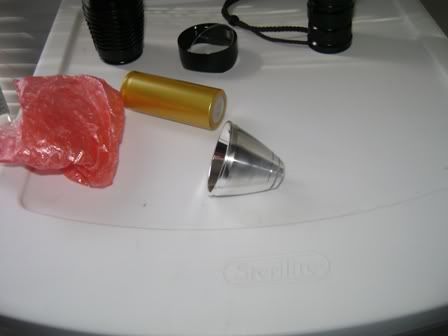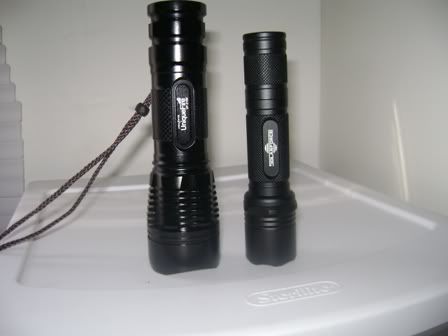Sorry, I am no Foy, but I will attempt to do my best.
I have had my eye on this light for a while, now. I finally pulled the trigger and received it from Manafont last week. The following couple of photos re-enact the "unboxing":


As you can see in the next photo, the battery is not the blue one shown on MF's site but it seems to work well, it definitely lasts longer than the 18650, "3000 mAh" TF Flames in my Solarforce L2/L2P's (need to make an adapter to use in this light for a direct comparison) The battery has no brand markings only: "INR26650E 4000mAh 3.7V":

The following shows the pill, which looks like they could/should have made larger for better heat conduction to the body. The fins on the body look to be pretty functional, although while on high for a while, the light will get quite warm.

The next shows the profile of the reflector:

Size comparison with my black L2P (sorry, it got cut off a little at the top, but there is enough of the top to give a good indication of the relative size):

My impressions:
Overall, I think it has a very good build quality, even came with lubed threads. Not quite up to par of Solarforce, but not too bad. I noticed a couple of machining errors and very light machining marks, you have to look fairly close to see them. Lens is plastic. Not up to par, IMHO, for a $57 light, though.
Just like Manafont's description says, it comes with 3 modes, High-Low-Flashy. I wish it had a medium and no flashy, but I may mod it to the 2.8 amp driver everyone raves about.
It is similar in size to my 2 C cell Pelican light that I had, which this replaces (batteries leaked and destroyed the light beyond my wanting to toy with it anymore). That light was more throwy than this light (smaller hotspot), but the overall light output of this light is such that it lights a larger area at the same distance much brighter than the Pelican, although I cannot test each to see which has the best throw overall, since the Pelican is dead and gone. As you can see, the light is a little longer than a SF L2P, but is considerably thicker due to the larger battery. It feels good in hand, though is not really a good EDC because of the additional heft and size. Despite the lanyard, it does tailstand.
I bought this because, spec wise it was on par with the well regarded C8 sized light, but with a larger battery. I don't own a C8, so I thought this may satisfy my C8 urge and give me the longer runtime of the larger battery. I believe, in this regard, this succeeded, although I understand the reflector is longer than the C8, so the throw/spill is not exactly the same.
Beamwise, it is equal in brightness to the MF 3 mode drop-in that I use in my SF's. However, the hotspot is much better defined and it has better throw and very bright spill to light up a larger area brighter than the SF's I have. I hope to post outdoor and indoor beam shots for comparison later this week.
For anyone who is looking for an extended runtime bike light, I think this would be a good choice, however, I think modd'ing it with the 2.8amp, 3 mode driver should be done first, this way you could use the medium brightness as I am not entirely confident that the fins will keep the flashlight cool enough on high to use for an extended period (such as bike riding would require).
The Good:
- Good throw with enough spill to brightly light up a good area.
- Long runtime due to the 26650 battery.
- Overall, good quality and fairly well made.
- Fins should provide good heat transfer.
The Bad:
- Build quality not quite up to a nearly $60 light, IMHO. More like in the $35 range.
- Not good for EDC.
- Pill could have been thicker for even better heat transfer (they had to machine it down to the thickness it is, probably could have saved a few bucks not machining all that ally away).
- Takes a while for the body to warm up, on high, but once it does, it can get pretty warm fast.
The Indifferent:
- Comes with charger, have not used it, am using my Xtar WPII charger plus $0.15 to charge the battery (literally since the battery does not fit the charger, I needed a way to get the positive on the charger to contact the battery and a nickel and dime worked great). Not sure that I can trust the charger that came with the light to not overcharge the battery, which I can trust the Xtar not to do.
The big question:
Would I buy this light again, knowing its faults? Answer: Yes. I actually knew going into the purchase some of the faults (i.e. non-EDC, its size, potential at having to upgrade the driver, etc.), so mainly the faults I did not anticipate, like the machining and the thickness of the pill, were really only minor, IMHO. Just that for a nearly $60 I had hoped the machining would have been on par with SF, and it really would not have taken much to make it so.
Let me know if there are any points that I missed that you'd like me to comment on. This is my first review, so criticism is encouraged (preferably constructive). I will try to get beam shots posted later this week or next weekend.
Edit: Sorry, I have not done the beam shots, yet. However, I have taken tailcap measurements. For what it's worth, I am getting around 3+ amps on high with not quite a fully charged battery, but close to it. Did not take readings on low.

 Actually, I guess MF's description could be "technically" right as it appears to be a thin "Plexiglass", hence glass in the name, glass in the description.
Actually, I guess MF's description could be "technically" right as it appears to be a thin "Plexiglass", hence glass in the name, glass in the description. 